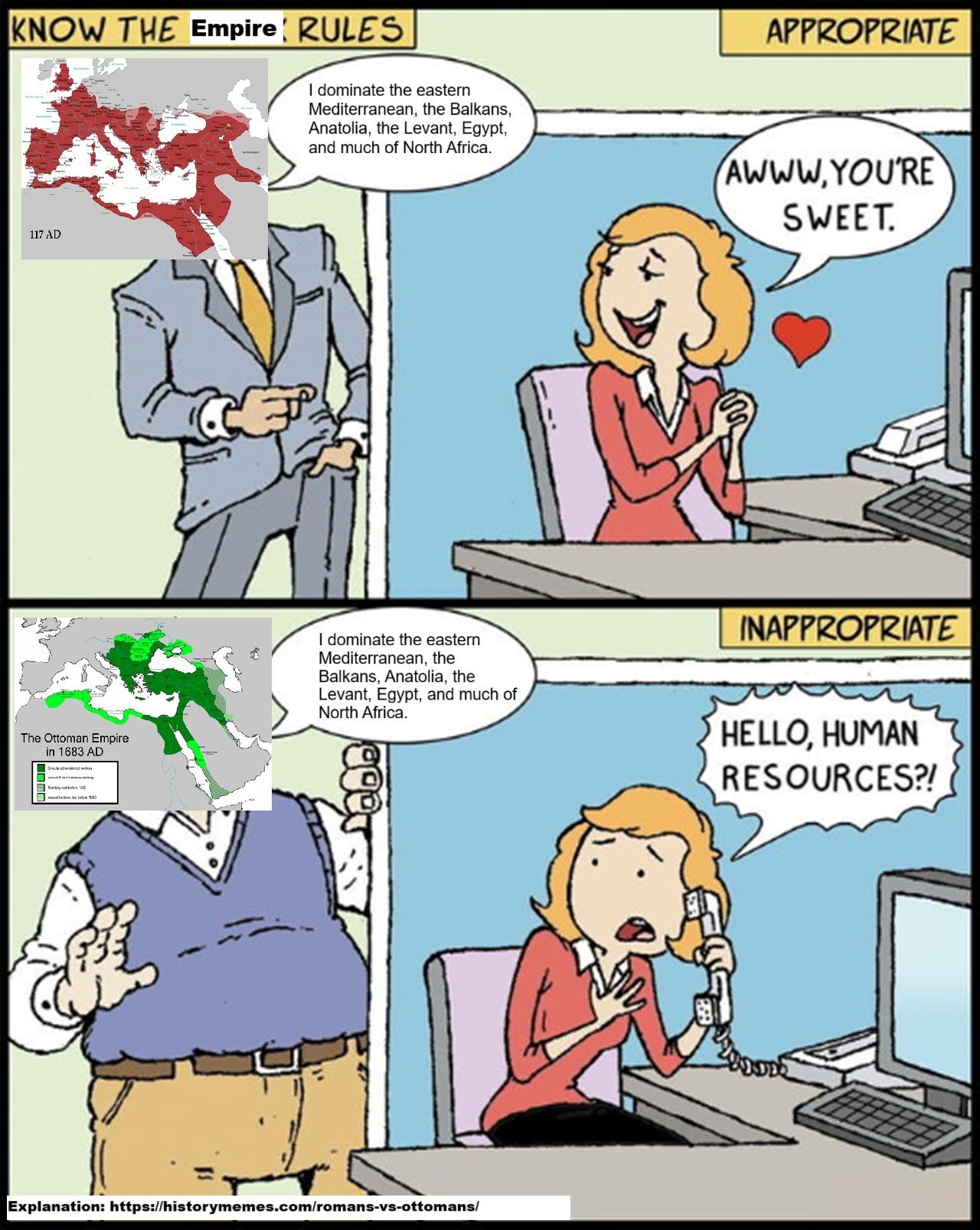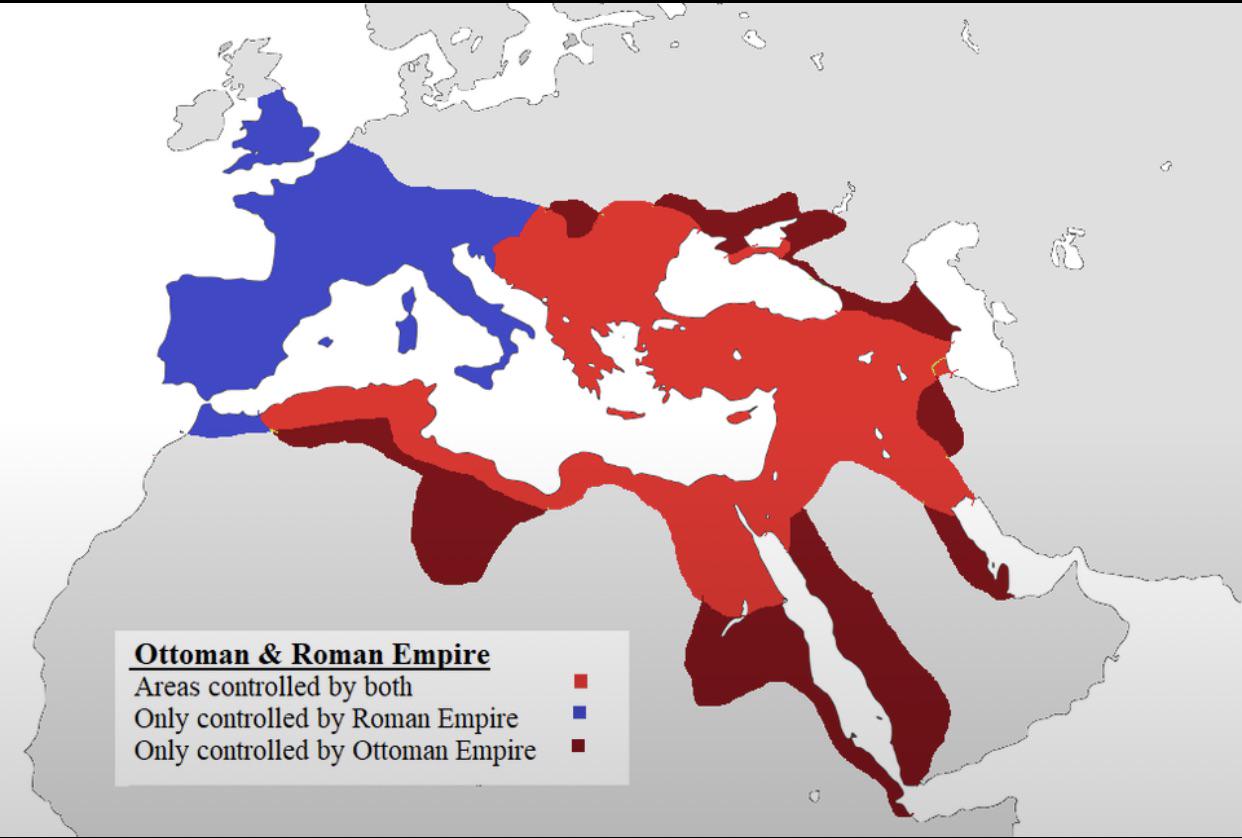
The meme above shows how people in the West tend to view the Roman and Ottoman Empires respectively. Here’s more about them and why the differences:
Areas Covered
Here’s a map showing them both at their respective peaks including areas they both controlled at some point:
- Roman Empire (27 BCE – 476 CE in the West, 1453 CE in the East/Byzantine)
- At its height under Trajan (117 CE), it stretched from Britain to Mesopotamia, and from the Rhine/Danube to North Africa.
- Controlled nearly the entire Mediterranean basin, earning the phrase Mare Nostrum (“our sea”).
- Ottoman Empire (c. 1299 – 1922 CE)
- At its peak under Suleiman the Magnificent (16th century), it included Anatolia, the Balkans, the Middle East, and North Africa.
- Spanned from Hungary to the Arabian Peninsula, and from Algeria to the Caucasus.
- Like Rome, it was a true “Mediterranean empire,” but also more firmly tied to the Islamic world.
Longevity
- Rome:
- If you count from Augustus (27 BCE) to the fall of Constantinople (1453 CE), the Roman world lasted almost 1,500 years (with East/Byzantine continuity).
- The Western Roman Empire itself lasted about 500 years.
- Ottomans:
- Lasted about 623 years (c. 1299–1922).
- That’s longer than the Western Roman Empire, shorter than Rome + Byzantium combined, but still one of history’s longest-lasting dynasties.
Religion
- Rome:
- Polytheistic until the 4th century, when Christianity became the state religion (Edict of Thessalonica, 380 CE).
- Christianity, which emerged from the empire, became the dominant religion of Europe and later the Americas.
- Ottomans:
- Sunni Islam was the state religion.
- Christians and Jews were considered dhimmi (“protected peoples”), allowed to practice their religion but with special taxes and social restrictions.
- Their role as caliphs (from 1517 onward) gave them leadership over much of the Sunni Islamic world.
Governance & Culture
- Rome:
- Emphasis on Roman law, Latin/Greek language, urban planning, and engineering.
- Citizenship gradually expanded; the ius civile and ius gentium formed the roots of European legal systems.
- Classical Greco-Roman heritage became the foundation of Western identity.
- Ottomans:
- Highly centralized under the sultan, with a mix of Islamic law (sharia) and imperial decrees (kanun).
- Used the millet system to grant limited autonomy to religious communities.
- Left legacies in art, architecture (mosques, palaces), cuisine, and music, especially in south-eastern Europe and the Middle East.
Military Power
- Rome:
- Famous for its legions, roads, and disciplined military system.
- Expanded steadily, then shifted to defense after 2nd century CE.
- Ottomans:
- Famous for the Janissaries (elite infantry corps), use of gunpowder artillery, and naval dominance in the 16th century.
- Like Rome, their military was both an engine of expansion and eventually a source of internal weakness when reforms lagged.
And finally:
Why the Roman Empire is Viewed More Positively in the West?
- Cultural Heritage:
- Western Europe claims direct descent from Rome: Latin languages, Roman law, republican ideals, Christianity, architecture.
- Rome is framed as the “ancestor” of Western civilization, despite its brutality.
- Historical Narrative:
- The Renaissance and Enlightenment revived “classical antiquity” as an ideal.
- Rome was romanticized as a model of order, law, and civilization.
- Ottomans as “the Other”:
- The Ottomans were non-Christian, Muslim rulers, often seen as an existential threat to Christian Europe (Siege of Vienna 1529 & 1683, wars in the Balkans, Mediterranean naval rivalry).
- Their conquest of Constantinople in 1453 was framed as the “fall of Christian civilization” in the East.
- European nationalism in the 19th century cast the Ottomans as “backward” and oppressive, especially in the Balkans.
- Timing of Decline:
- Rome fell over a millennium ago, giving it a mythic, nostalgic glow.
- The Ottoman decline happened in the modern era (18th–20th centuries), when Western powers portrayed them as the “sick man of Europe” to justify imperial encroachment.
More about them:

Leave a Reply